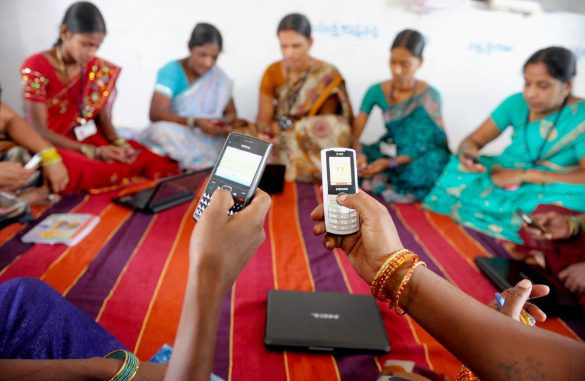
Indumati Mahato, from West Bengal’s Purulia district, has discovered a whole new world thanks to the Internet. Taking the help of an initiative titled Internet Saathi, Mahato has begun accessing the internet on her smartphone. Recently, she helped a pregnant women from her village find a suitable centre in the neighbouring district to deliver a child.
Software company Google in partnership with Tata Trust has launched the Internet Saathi scheme to bridge the digital gender gap in rural India by empowering women with online access. “At first, many questioned us about the benefits of using the Internet. When a pregnant woman in our village found it difficult to access a healthcare centre to deliver her baby, I used the Internet to find a place in Jharkhand nearby. People have now started to realise how the Internet can help us,” said Mahato, who earns Rs 1,000 per month as remuneration under the initiative.
At villages such as these across India, Internet-based learning is gradually extending its reach, luring children back to school and helping villagers improve their lives and grow their businesses. In Karnataka, silk weavers have discovered newer ways of producing silk by watching videos on YouTube. Hundreds of miles away in Bilaspur, Chhattisgarh, high school students are using the Internet to learn English.
With a population of over one billion, the government has a challenging task in ensuring universal elementary education. While there has been an increase in the number of educational institutes across the country, over the last decade, the problem of illiteracy in rural areas, particularly among the female population, still remains unsolved. Can the digital divide be bridged by the digital dividend from India’s leadership in information and communication technology?
India’s IT majors have taken up the challenge and are gearing up to win a new battleground — the rural masses. Education, the lynchpin of e-governance, IT services and the bedrock of India’s outsourcing powerhouse in IT-enabled services, is now in focus with all majors ranging from global players in IT hardware to curriculum design hotshots marking out their territory.
After a series of urban initiatives such as providing free wi-fi in railway stations and creating a $20,000 start-up fund, Google is now eyeing to increase its presence in rural India. The software company, in association with Tata Trust is providing a bicycle, mobile and tablet devices, training materials to women who are trained by these companies to become Internet Saathis or master trainers. These Internet Saathis, in turn, reach out to people in the village helping them with web-based information apart from providing training to other women in the village to make them e-literate.
“The programme not only helps women access information and services but is also empowering them socially and economically,” says Ganesh Neelam, head of innovation at Tata Trust. Google India is paying them Rs 1,000 a month for a period of six months. “These women can also charge a nominal fee from the villagers to whom they are providing the required information. This way, they become the agents of change in rural India,” says Sapna Chadha, head of marketing at Google India.
The initiative has already been rolled out in nine states and around 500 women are being roped into the programme every week. Under this rural connect initiative, Google is providing the requisite material in vernacular languages and also engaging with other companies to develop content in the local language. According to Google officials, while this drive will help rural India adopt to the world of information and technology, the company will benefit with the increase in Internet usage.
Other companies such as Wipro, HCL, Infosys Foundation and Microsoft have also been engaged in providing digital access to underserved rural communities in the country. These companies have committed to significant investments to plug gaps in the country’s rural education space.
Next-gen digital ICT education is the way ahead for India, if it has to maintain its growth rate and be an economic superpower. India spends 4.1 per cent of its GDP on education and ICT tools are seen as important enablers that can support the move from traditional teacher-centric teaching styles to learner-centric methods. Given the paucity of teachers and the lack of basic infrastructure, such as roads, pervasive data and telecom networks, newer forms of education delivery are becoming the norm to bridge the divide.
Rural education experts say, while ICT and corporate participation is providing a virtual workaround to traditional government supported programmes in spreading education in an environment where a majority of rural population continues to be underserved with infrastructure and basic amenities, unless major priorities such as hygienic sanitation, access to safe drinking water and access to basic healthcare are not provided, the government’s aim of universal education access will continue to leave behind the girl child, as well as the more socially and financially disadvantaged rural children.
Source: Enterprise Innovation

Leave a Reply